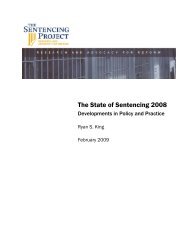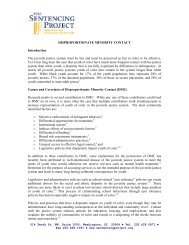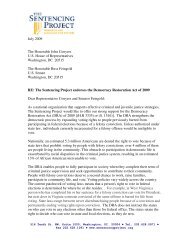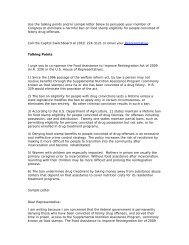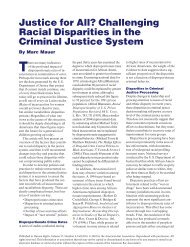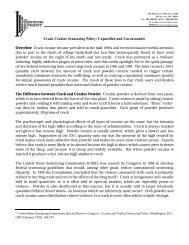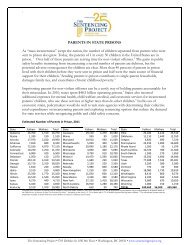Incarceration and Crime - The Sentencing Project
Incarceration and Crime - The Sentencing Project
Incarceration and Crime - The Sentencing Project
Create successful ePaper yourself
Turn your PDF publications into a flip-book with our unique Google optimized e-Paper software.
<strong>Incarceration</strong> <strong>and</strong> <strong>Crime</strong>:<br />
A Complex Relationship<br />
“<br />
Increasing incarceration<br />
while ignoring more effective<br />
approaches will impose a<br />
heavy burden upon<br />
courts, corrections <strong>and</strong><br />
communities, while<br />
providing a marginal<br />
impact on crime.<br />
”
This report was written by Ryan S. King (Research Associate), Marc Mauer (Executive Director) <strong>and</strong><br />
Malcolm C. Young (Executive Director, 1986–2005) of <strong>The</strong> <strong>Sentencing</strong> <strong>Project</strong>.<br />
Graphic Design by Michael T. Powell.<br />
<strong>The</strong> <strong>Sentencing</strong> <strong>Project</strong> is a national nonprofit organization that works for a fair <strong>and</strong> effective criminal<br />
justice system by promoting alternatives to incarceration, reforms in sentencing law <strong>and</strong> practice, <strong>and</strong><br />
better use of community-based services <strong>and</strong> institutions. To these ends, it seeks to recast the public<br />
debate on crime <strong>and</strong> punishment.<br />
Funding for this project was provided by the JEHT Foundation, the Open Society Institute <strong>and</strong><br />
individual donors to <strong>The</strong> <strong>Sentencing</strong> <strong>Project</strong>.<br />
Copyright © 2005 by <strong>The</strong> <strong>Sentencing</strong> <strong>Project</strong>. Reproduction of this document in full or in part, in print<br />
or electronic format, only by permission of <strong>The</strong> <strong>Sentencing</strong> <strong>Project</strong>.<br />
For further information: <strong>The</strong> <strong>Sentencing</strong> <strong>Project</strong>, 514 10th Street N.W., Suite 1000, Washington. D.C.<br />
20004. Telephone: 202-628-0871.<br />
www.sentencingproject.org<br />
email: staff@sentencingproject.org
<strong>Incarceration</strong> <strong>and</strong> <strong>Crime</strong><br />
Over the past thirty<br />
years the United States<br />
has experienced an<br />
unprecedented rise in<br />
the use of incarceration,<br />
with the number of people in prisons<br />
<strong>and</strong> jails increasing from 330,000 in<br />
1972 to 2.1 million today. This trend is in<br />
sharp contrast to that of the preceding<br />
fifty years, during which time there<br />
was a gradual increase in the use of<br />
incarceration that was commensurate<br />
with growth in the general population.<br />
Between 1920 <strong>and</strong> 1970 the overall<br />
population nearly doubled, while the<br />
number of people in prison increased<br />
at just a slightly higher pace. However,<br />
between 1970 <strong>and</strong> 2000, while the general<br />
population rose by less than 40%, the<br />
number of people in prison <strong>and</strong> jail rose<br />
by more than 500%. Potential explanations<br />
for this dramatic change in policy have<br />
included changing crime rates, politics,<br />
demographics, <strong>and</strong> cultural shifts. <br />
<strong>The</strong> record decline in crime during the<br />
1990s has added an additional element<br />
to the discussion. Advocates of increased<br />
use of incarceration have contended that<br />
the significant growth in incarceration has<br />
been the primary factor responsible for<br />
this reduction. <strong>The</strong> two-pronged approach<br />
of tougher sentences <strong>and</strong> restrictive<br />
release patterns are the primary cause,<br />
proponents claim, of this sustained crime<br />
drop. Nowhere has the adoption of tougher<br />
sentencing rules <strong>and</strong> release policies been<br />
more evident than in the federal system,<br />
where m<strong>and</strong>atory minimums, sentencing<br />
guidelines, <strong>and</strong> the abolition of parole have<br />
combined to create an extremely punitive<br />
system. <strong>The</strong> Department of Justice, in<br />
supporting this approach, has stated that<br />
“tough sentencing means less crime,” <strong>and</strong><br />
that “[t]he <strong>Sentencing</strong> Guidelines have<br />
helped reduce crime by ensuring that<br />
criminal sentences take violent offenders<br />
off the streets, impose just punishment <strong>and</strong><br />
deter others from committing crimes.” <br />
Despite these assertions by the Department<br />
of Justice, such a direct link is far from an<br />
accepted fact. As policymakers consider<br />
responses, including the adoption of a host<br />
of additional m<strong>and</strong>atory minimums, to<br />
the Supreme Court’s 2005 remedial ruling<br />
making the federal guidelines advisory<br />
in U.S. v. Booker, it is important to assess<br />
what is actually known about the impact of<br />
imprisonment on crime control.<br />
Figure 1<br />
Incarcerated Persons in<br />
State <strong>and</strong> Federal Prisons, 1925-2004<br />
1,500,000<br />
1,200,000<br />
900,000<br />
600,000<br />
300,000<br />
0<br />
91,669<br />
166,123<br />
210,895<br />
1,085,022<br />
739,980<br />
480,568<br />
315,974<br />
1,331,278<br />
1,494,216<br />
1925 1950 1965 1980 1985 1990 1995 2000 2004<br />
Note: Figures do not include persons in local jails.<br />
<br />
For a discussion of the possible explanations for this shift<br />
in incarceration policy, see Garl<strong>and</strong>, D. (2001). <strong>The</strong> Culture<br />
of Control: <strong>Crime</strong> <strong>and</strong> Social Order in Contemporary Society.<br />
Chicago: University of Chicago Press.<br />
<br />
Prepared Remarks of Assistant Attorney General Christopher<br />
A. Wray, Response to Booker/Fanfan, January 12, 2005.
<strong>Incarceration</strong><br />
<strong>and</strong> <strong>Crime</strong><br />
Analyzing the Relationship<br />
Between <strong>Incarceration</strong> <strong>and</strong> <strong>Crime</strong><br />
<strong>The</strong> relationship between incarceration<br />
<strong>and</strong> crime is complex. Researchers<br />
have struggled to quantify accurately<br />
the degree to which crime reduction is<br />
attributable to imprisonment. Among<br />
the many challenges associated with the<br />
issue are the following: distinguishing<br />
between state <strong>and</strong> national trends; differing<br />
measures of crime <strong>and</strong> victimization;<br />
<strong>and</strong>, assessing various time frames for<br />
analysis. In addition to incarceration,<br />
studies have identified a range of factors<br />
which may affect crime, including general<br />
economic trends, employment rates, age,<br />
demographics, rates of drug abuse, <strong>and</strong><br />
geographic variation. This briefing paper<br />
provides an aid to policymakers <strong>and</strong> the<br />
public by reviewing what is known about<br />
the effects of incarceration on crime.<br />
Differing Methods of Measuring<br />
<strong>Crime</strong> Rates <strong>and</strong> Victimization<br />
<strong>The</strong>re are two primary measures of crime<br />
used in the United States. <strong>The</strong> Uniform<br />
<strong>Crime</strong> Reports (UCR) produced annually<br />
by the FBI measure crimes reported to the<br />
police. <strong>The</strong> UCR Index <strong>Crime</strong> measure<br />
is a composite of eight serious violent<br />
<strong>and</strong> property offenses, <strong>and</strong> is commonly<br />
Figure 2<br />
Divergent Trends in<br />
<strong>Incarceration</strong> <strong>and</strong> <strong>Crime</strong> Rates<br />
1984–1991 1991–1998<br />
% Increase<br />
IN rate of % increase in<br />
incarceration crime rate<br />
65%<br />
17%<br />
% Increase<br />
IN rate of % Decrease in<br />
incarceration crime rate<br />
47%<br />
referred to as the “crime rate” in the<br />
media. Victimization studies conducted<br />
by the Department of Justice measure<br />
crime through surveys of households,<br />
asking occupants about crimes committed<br />
against them <strong>and</strong> whether or not they<br />
reported them to the police (less than half<br />
of all serious crimes are reported to the<br />
police). Each means of measurement has<br />
its advantages. <strong>The</strong> victimization studies<br />
provide a broader view of total crime<br />
because they account for the many crimes<br />
not reported to the police, while the UCR<br />
provides a better sense of trends in the<br />
most serious crimes. Trends in the two<br />
measurements have been inconsistent<br />
in some time periods, but they match up<br />
about 60 to 75% of the time, depending<br />
on the type of crime measured. However,<br />
most popular discussion of crime rates<br />
relies primarily on UCR data because of its<br />
focus on serious crime.<br />
Neither of these crime measures<br />
incorporate any assessment of drug<br />
offenses, since personal drug use or<br />
drug sales, apart from those resulting in<br />
arrests, are not reported to the police or as<br />
victimizations. <strong>The</strong> proportion of arrests,<br />
convictions, <strong>and</strong> persons incarcerated for<br />
drug offenses has increased dramatically<br />
in the past two decades. Accordingly, this<br />
absence of data greatly obscures the overall<br />
number of people engaged in illegal activity<br />
<strong>and</strong> skews the national perception of actual<br />
trends in criminal activity.<br />
Apparent Trends Depend Upon<br />
Time Frame Examined<br />
While there has been a great deal of<br />
discussion <strong>and</strong> speculation regarding<br />
the crime decline since the early 1990s, a<br />
focus on this period risks employing an<br />
overly narrow view of the relationship<br />
between incarceration <strong>and</strong> crime. To be<br />
more completely analyzed, this relationship<br />
should incorporate an assessment of the<br />
unprecedented increase in imprisonment<br />
since 1972. From a combined inmate<br />
-22%<br />
<br />
R<strong>and</strong>, M.R. <strong>and</strong> Rennison, C.M. (2002). “True <strong>Crime</strong><br />
Stories? Accounting for Differences in our National <strong>Crime</strong><br />
Indicators,” Chance, Vol. 15 (1), p. 47-51.<br />
<br />
Bureau of Justice Statistics, Drug & <strong>Crime</strong> Facts, . Accessed August<br />
29, 2005.
population of about 330,000 in prison <strong>and</strong><br />
jail in 1972, there has since been a five-fold<br />
increase to a total of 2.1 million as of 2004.<br />
This escalating growth over a 30-year<br />
period has been accompanied by sharply<br />
divergent trends in crime rates. We can see<br />
this clearly in looking at the 14-year time<br />
frame of 1984-1998. During this period,<br />
incarceration rates rose consistently,<br />
by 65% in the first seven-year period of<br />
1984-91, <strong>and</strong> then by 47% from 1991-98.<br />
Yet crime rates fluctuated in this period,<br />
first increasing by 17% from 1984-91, then<br />
declining by 22% from 1991-98. (See Fig. 2).<br />
<strong>The</strong>re were also divergent trends in<br />
crime rates among the states during the<br />
crime decline period of 1991-1998. A<br />
number of states with large increases in<br />
incarceration experienced smaller drops in<br />
crime than did states that increased their<br />
use of imprisonment at a lower rate. For<br />
example, Texas, with a 144% increase in<br />
incarceration <strong>and</strong> California, with a 52%<br />
increase, experienced considerable declines<br />
in crime (35% <strong>and</strong> 36% respectively), but<br />
New York experienced a 43% decline in<br />
crime despite an increase in incarceration<br />
of only 24%. An overview of changes in<br />
incarceration <strong>and</strong> crime in all 50 states<br />
reveals no consistent relationship between<br />
the rate at which incarceration increased<br />
<strong>and</strong> the rate at which crime decreased.<br />
<strong>The</strong>se inconsistent trends over time<br />
<strong>and</strong> among the states do not necessarily<br />
suggest that incarceration has no impact<br />
on crime, but they inform us that<br />
incarceration does not always have a<br />
uniformly positive impact on reducing<br />
crime <strong>and</strong> that, therefore, other factors<br />
significantly affect crime trends.<br />
While the nation celebrates a reported<br />
crime rate that is near a 40-year low, it<br />
is instructive to note that despite the<br />
addition of more than one million persons<br />
to the prison population (excluding jail<br />
inmates), crime rates are only at the level<br />
at which they were at a time when the<br />
number of prisoners was just a fraction of<br />
the total today. <br />
<strong>The</strong> <strong>Crime</strong> Decline<br />
of the Past Decade<br />
Nationally, violent crime has declined by<br />
33% <strong>and</strong> property crime has decreased<br />
23% since 1994. During the same period<br />
incarceration rates rose by 24%. Some<br />
commentators draw upon these two<br />
trends to support the conclusion that<br />
incarceration “works” to reduce crime.<br />
<strong>The</strong> reality is far more complex.<br />
References to national data<br />
alone obscure the significance of<br />
the experience in the states as they<br />
utilize different strategies <strong>and</strong> achieve<br />
different results. A recent study that<br />
analyzed state prison <strong>and</strong> crime data<br />
revealed that there was no discernible<br />
pattern of states with higher rates of<br />
increase in incarceration experiencing<br />
more significant declines in crime. <br />
Between 1991 <strong>and</strong> 1998, those states<br />
that increased incarceration at rates<br />
that were less than the national average<br />
experienced a larger decline in crime<br />
rates than those states that increased<br />
incarceration at rates higher than the<br />
national average (See Fig. 3).<br />
Figure 3<br />
Changes in <strong>Incarceration</strong> <strong>and</strong><br />
<strong>Crime</strong> Rates for states<br />
grouped by above average <strong>and</strong> below average<br />
increases in incarceration, 1991-1998<br />
above average<br />
% Increase<br />
IN rate of % Decrease in<br />
incarceration crime rate<br />
72%<br />
-13%<br />
below average<br />
% Increase<br />
IN rate of % Decrease in<br />
incarceration crime rate<br />
30%<br />
-17%<br />
<strong>Incarceration</strong><br />
<strong>and</strong> <strong>Crime</strong><br />
<br />
Historical rates from Tonry, M. (1995). Malign Neglect:<br />
Race, <strong>Crime</strong>, <strong>and</strong> Punishment in America. New York: Oxford<br />
University Press. Pp. 22-23; current rates from Federal<br />
Bureau of Investigation. <strong>Crime</strong> in the United States, 2003.<br />
Washington, DC.<br />
<br />
Gainsborough, J. & Mauer, M. (2000). Diminishing Returns:<br />
<strong>Crime</strong> <strong>and</strong> <strong>Incarceration</strong> in the 1990s. Washington, DC: <strong>The</strong><br />
<strong>Sentencing</strong> <strong>Project</strong>. (p. 10).
<strong>Incarceration</strong><br />
<strong>and</strong> <strong>Crime</strong><br />
Trends between 1998 <strong>and</strong> 2003 at<br />
the state level continue to demonstrate<br />
no significant impact of increased<br />
incarceration rates on reducing crime.<br />
Since 1998, 12 states experienced stable<br />
or declining incarceration rates, yet the<br />
12% average decrease in crime rates in<br />
these states was the same as in the 38<br />
states in which rates of imprisonment<br />
increased. If incarceration was having<br />
the impact on crime that proponents<br />
suggest, then those states with higher<br />
increases in incarceration rates should<br />
have experienced more substantial<br />
declines in crime rates.<br />
Economist Steven Levitt has identified<br />
the growth in the use of incarceration<br />
as one of four primary factors leading to<br />
“About 25% of the decline<br />
in violent crime can be<br />
attributed to increased<br />
incarceration.<br />
While one-quarter of<br />
the crime drop is not<br />
insubstantial, we then know<br />
that most of the<br />
decline — three-quarters<br />
— was due to factors other<br />
than incarceration.”<br />
the decline in crime during the 1990s. <br />
In a 1996 article looking at the impact of<br />
prison on crime rates, Levitt argued that<br />
each incarcerated person results in the<br />
prevention of approximately 15 crimes. <br />
However, Levitt’s model predicts that<br />
the majority of crime that is prevented<br />
by incarceration is comprised of “less<br />
socially costly property crimes.” Does<br />
this approach necessarily represent the<br />
<br />
Levitt, S.D. (2004). “Underst<strong>and</strong>ing Why <strong>Crime</strong> Fell in<br />
the 1990s: Four Factors that Explain the Decline <strong>and</strong> Six<br />
That Do Not,” Journal of Economic Perspectives, Vol. 18 (1),<br />
163-190.<br />
<br />
Levitt, S.D. (1996). “<strong>The</strong> Effect of Prison Population Size<br />
on <strong>Crime</strong> Rates: Evidence from Prison Overcrowding<br />
Litigation,” <strong>The</strong> Quarterly Journal of Economics, Vol. 111 (2),<br />
319-351. (p. 345).<br />
<br />
Ibid.<br />
most efficient allocation of resources?<br />
Levitt seems to think not, stating that<br />
“the social benefit of radically exp<strong>and</strong>ing<br />
the prison population through the<br />
incarceration of increasingly minor<br />
criminals is likely to be well below the<br />
estimates presented here.” 10 Levitt’s<br />
analysis suggests that about 80% of the<br />
crime prevented by the incarceration<br />
of each additional prisoner is for nonviolent<br />
offenses. In a recent article, he<br />
notes that “it seems quite plausible that<br />
substantial indirect costs are associated<br />
with the current scale of imprisonment,”<br />
including the impact on the African<br />
American community, <strong>and</strong> that “further<br />
increases in imprisonment may be less<br />
attractive than the naïve cost benefit<br />
would suggest.” 11 This most recent<br />
caveat acknowledges the limited role of<br />
incarceration as a strategy to address<br />
crime, <strong>and</strong> recognizes the complexity of<br />
trying to base policy decisions solely on<br />
financial costs.<br />
More recent analysis of the<br />
contributing factors to the crime decline<br />
of the 1990s suggests that about 25%<br />
of the decline in violent crime can be<br />
attributed to increased incarceration. 12<br />
While one-quarter of the crime drop<br />
is not insubstantial, we then know that<br />
most of the decline in crime — threequarters<br />
— was due to factors other than<br />
incarceration. Several factors st<strong>and</strong> out as<br />
key in this regard:<br />
Growing Economy – <strong>The</strong> relatively<br />
strong economy of the 1990s produced<br />
jobs <strong>and</strong> opportunity, particularly for<br />
lower-wage workers. One study estimates<br />
that this factor was responsible for 30% of<br />
the decline in crime. 13<br />
Changes in Drug Markets – <strong>The</strong><br />
crack cocaine epidemic of the late 1980s,<br />
combined with the availability of guns<br />
in many communities, was a significant<br />
10<br />
Ibid, p. 347.<br />
11<br />
Levitt, 2004, p. 179.<br />
12<br />
Spelman, W. (2000). “<strong>The</strong> Limited Importance of Prison<br />
Expansion,” In Blumstein, A. <strong>and</strong> Wallman, J. (Eds.), <strong>The</strong><br />
<strong>Crime</strong> Drop in America. Cambridge, UK: Cambridge University<br />
Press. (pp. 97-129).<br />
13<br />
Freeman, R. <strong>and</strong> Rodgers, III, W. (1999). Area Economic<br />
Conditions <strong>and</strong> the Labor Market Outcomes of Young Men in<br />
the 1990’s Expansion. Cambridge, MA: National Bureau of<br />
Economic Research.
Figure 4<br />
Proportion of federal Prisoners<br />
Incarcerated for Drug Offenses<br />
<strong>Incarceration</strong><br />
<strong>and</strong> <strong>Crime</strong><br />
80<br />
70<br />
Percent of Total Population<br />
60<br />
50<br />
40<br />
34.3%<br />
52.2%<br />
60.7%<br />
56.9%<br />
30<br />
24.9%<br />
20<br />
1980 1985 1990 1995 2000<br />
contributor to rates of violence for several<br />
years. 14 By the early 1990s, crack use<br />
began to wane, along with much of the<br />
associated violence of the drug market,<br />
<strong>and</strong> homicide rates for young African-<br />
American males in particular dropped<br />
significantly. 15 <strong>The</strong>se developments were<br />
similar to previous drug epidemics, which<br />
are typically of short duration. 16<br />
Strategic Policing – Law enforcement<br />
agencies in many cities adopted various<br />
forms of community policing in the 1990s.<br />
In at least some cities, these approaches<br />
are believed to have contributed to<br />
significant declines in crime. In San<br />
Diego, for example, a comprehensive<br />
model of community policing contributed<br />
to a greater than 40% decline in crime<br />
rates from 1990-1996. 17 This was the<br />
second largest drop in the country, <strong>and</strong><br />
it occurred not through the hiring of<br />
14<br />
Levitt, 2004, pp. 179-181.<br />
15<br />
Ibid.<br />
16<br />
Musto, D.F. (1999). <strong>The</strong> American Disease: Origins of Narcotic<br />
Control. New York: Oxford University Press.<br />
17<br />
Eck, J.E. & Maguire, E.R. (2000). “Have Changes in<br />
Policing Reduced Violent <strong>Crime</strong>?: An Assessment of the<br />
Evidence,” in Blumstein, A. <strong>and</strong> Wallman, J. (eds.). <strong>The</strong><br />
<strong>Crime</strong> Drop in America. Cambridge: Cambridge University<br />
Press. (pp. 207-265).<br />
additional officers, but by making better<br />
use of current staffing <strong>and</strong> instituting a<br />
problem-solving strategy. In Boston, a<br />
police-community partnership targeting<br />
the distribution of firearms contributed to a<br />
dramatic decline in youth homicides as well.<br />
Community Responses to <strong>Crime</strong> –<br />
Witnessing the devastation wrought by<br />
drug markets <strong>and</strong> the “war on drugs” in a<br />
number of communities had a profound<br />
effect on young people in the 1990s.<br />
Seeing the impact of drug addiction<br />
on family <strong>and</strong> friends led a significant<br />
number of young people to choose to<br />
refrain from engaging in drug use or<br />
distribution in communities that had<br />
been plagued by narcotics. A study of a<br />
Brooklyn neighborhood noted that “the<br />
multiple threats of violence, crime, AIDS,<br />
<strong>and</strong> addiction” compelled many young<br />
people to “[withdraw] from the danger<br />
<strong>and</strong> [opt] for the relative safety of family,<br />
home, church <strong>and</strong> other sheltering<br />
institutions…” 18<br />
18<br />
Curtis, R. (1998). “<strong>The</strong> Improbable Transformation of Inner-City<br />
Neighborhoods: <strong>Crime</strong>, Violence, Drugs, <strong>and</strong> Youth<br />
in the 1990s,” <strong>The</strong> Journal of Criminal Law <strong>and</strong> Criminology,<br />
Vol. 88, (4), p. 1263.
<strong>Incarceration</strong><br />
<strong>and</strong> <strong>Crime</strong><br />
Limits of <strong>Incarceration</strong>’s Impact<br />
on Criminal Behavior<br />
For many people, the relationship<br />
between incarceration <strong>and</strong> crime rates<br />
seems intuitive. “If you lock people<br />
up, they can’t commit more crime.”<br />
However, the dynamics of both crime <strong>and</strong><br />
imprisonment challenge this seemingly<br />
commonsense notion. Among the reasons<br />
for incarceration’s limited impact on crime<br />
rates are:<br />
Diminishing Returns –Exp<strong>and</strong>ing the<br />
use of imprisonment inevitably results<br />
in diminishing returns in crime control.<br />
This is because high-rate <strong>and</strong> serious<br />
or violent offenders will generally be<br />
incarcerated even at modest levels of<br />
imprisonment, but as prison systems<br />
exp<strong>and</strong>, new admissions will increasingly<br />
draw in lower-rate offenders. This growth<br />
in lower-rate <strong>and</strong> lower-level offenders<br />
shifts the cost-to-benefit ratio, as an<br />
equal amount of resources are spent per<br />
offender, but the state receives less return<br />
on its investment in terms of declining<br />
crime rates. We have seen this trend most<br />
acutely in the federal system, where the<br />
pursuit of drug offenders has resulted<br />
in a growing proportion of low level<br />
offenders. More than half (56%) of federal<br />
drug offenders sentenced in 2002 were<br />
in the lowest criminal history category<br />
(Category I), <strong>and</strong> nearly 9 out of 10 (87%)<br />
had no weapon involvement.<br />
Limited Drug Offender Effects –<br />
Drug offenders have represented the<br />
most substantial source of growth in<br />
incarceration in recent decades, rising<br />
from 40,000 persons in prison <strong>and</strong> jail<br />
in 1980 to 450,000 today. Compared to<br />
other offenses, the effect of sentencing<br />
<strong>and</strong> incarceration on drug offenses<br />
is quite limited since drug selling is<br />
subject to a “replacement effect.” For<br />
example, if an armed robber is convicted<br />
<strong>and</strong> sentenced to prison, the effect of<br />
incapacitation removes that person’s<br />
crime potential during the period of<br />
imprisonment. But street-level drug<br />
sellers are often replaced quickly by<br />
other sellers seeking to make profits from<br />
the drug market. As criminologist Alfred<br />
Blumstein has noted, “… drug markets<br />
are inherently dem<strong>and</strong> driven. As long<br />
as the dem<strong>and</strong> is there, a supply network<br />
will emerge to satisfy that dem<strong>and</strong>.<br />
While efforts to assault the supply-side<br />
may have some disruptive effects in the<br />
short term, the ultimate need is to reduce<br />
the dem<strong>and</strong> in order to have an effect on<br />
drug abuse in the society.” 19<br />
<strong>The</strong>re are a number of ways to<br />
measure the prevalence of drug use,<br />
including national household survey<br />
data. Despite the fact that the number<br />
of persons in prison or jail today for<br />
drug offenses is more than ten times the<br />
number in 1980, drug use rates remain<br />
substantial, with data indicating a<br />
“Exp<strong>and</strong>ing the use of<br />
imprisonment inevitably<br />
results in diminishing<br />
returns in crime control.<br />
This is because high-rate <strong>and</strong><br />
serious or violent offenders<br />
will generally be incarcerated<br />
even at modest levels of<br />
imprisonment, but as<br />
prison systems exp<strong>and</strong>, new<br />
admissions will increasingly<br />
draw in lower-rate offenders.”<br />
general increase over the past few years.<br />
Thus, during a period when the number<br />
of persons in prison for drug law<br />
violations was growing at a rate faster<br />
than other offense types, the underlying<br />
behavior appears to have experienced<br />
very little impact.<br />
Limits of Federal <strong>Incarceration</strong> –<br />
<strong>The</strong> effect of incarceration on crime<br />
is even more limited in the federal<br />
prison system because of the offense<br />
characteristics of the federal prison<br />
population. As previously noted, the<br />
overall drop in crime was comprised<br />
19<br />
Blumstein, A. (1993). “Making Rationality Relevant – <strong>The</strong><br />
American Society of Criminology 1992 Presidential Address,”<br />
Criminology, Vol. 31, (1), p. 1-16.
Figure 5<br />
<strong>Incarceration</strong> <strong>and</strong> <strong>Crime</strong> Rates<br />
<strong>Incarceration</strong><br />
<strong>and</strong> <strong>Crime</strong><br />
600<br />
5,299<br />
5,950<br />
5,225<br />
5,803<br />
5,275<br />
6,000<br />
500<br />
469<br />
5,000<br />
<strong>Incarceration</strong> Rate per 100,000<br />
400<br />
300<br />
200<br />
100<br />
3,985<br />
96<br />
111<br />
139<br />
202<br />
297<br />
411<br />
4,125<br />
4,000<br />
3,000<br />
2,000<br />
1,000<br />
<strong>Crime</strong> Rate per 100,000<br />
0<br />
1970 1975 1980 1985 1990 1995 2000<br />
<strong>Crime</strong><br />
Prison<br />
0<br />
primarily of declines in violent <strong>and</strong><br />
property offenses. However, only 13% of<br />
federal prisoners have been convicted<br />
of a violent offense, while 55% are<br />
incarcerated for a drug offense (an<br />
increase from 25% in 1980). In addition,<br />
federal drug offenders are increasingly<br />
low-level. Two-thirds (66.5%) of crack<br />
cocaine offenders sentenced in 2000<br />
were either street-level dealers or<br />
couriers/mules, as were more than half<br />
(59.9%) of powder cocaine offenders.<br />
In both cases, these proportions<br />
represent a substantial increase from<br />
the proportion of low-level offenders in<br />
1995 (48.4% for crack cocaine <strong>and</strong> 38.1%<br />
for powder cocaine). 20<br />
Negative Impacts on Family <strong>and</strong><br />
Community – <strong>The</strong> rapid growth of<br />
incarceration has had profoundly<br />
disruptive effects that radiate into<br />
other spheres of society. <strong>The</strong> persistent<br />
removal of persons from the community<br />
20<br />
United States <strong>Sentencing</strong> Commission. Report to Congress:<br />
Cocaine <strong>and</strong> Federal <strong>Sentencing</strong> Policy. Washington, DC.<br />
May 2002.<br />
to prison <strong>and</strong> their eventual return<br />
has a destabilizing effect that has<br />
been demonstrated to fray family <strong>and</strong><br />
community bonds, <strong>and</strong> contribute to<br />
an increase in recidivism <strong>and</strong> future<br />
criminality. 21 Moreover, these trends<br />
are exacerbated as prisoners are<br />
increasingly incarcerated in facilities<br />
hundreds of miles from their homes.<br />
Research by the Urban Institute in<br />
a number of cities indicates that<br />
a critical predictor of success for<br />
persons returning to the community<br />
is family connections, <strong>and</strong> prospects<br />
for employment are strengthened for<br />
persons who are able to maintain some<br />
degree of attachment to their former<br />
networks of contacts. 22 However, as<br />
the use of incarceration continues to<br />
grow, there is a resultant decline in<br />
21<br />
Clear, T., Rose, D.R., Waring, E., <strong>and</strong> Scully, K. (2003).<br />
“Coercive Mobility <strong>and</strong> <strong>Crime</strong>: A Preliminary Examination<br />
of Concentrated <strong>Incarceration</strong> <strong>and</strong> Social Disorganization,”<br />
Justice Quarterly, Vol. 20, (1), pp. 33-64.<br />
22<br />
See publications by the Justice Policy Center of the Urban<br />
Institute for coverage of the reentry issue. Available online at<br />
www.urban.org
<strong>Incarceration</strong><br />
<strong>and</strong> <strong>Crime</strong><br />
these contacts, <strong>and</strong> a harmful impact<br />
on the individual, the family, <strong>and</strong> the<br />
community at large. 23<br />
Impact of <strong>Incarceration</strong><br />
Compared to Other Interventions<br />
Estimates that about one-quarter of<br />
the drop in crime during the 1990s can<br />
be attributed to incarceration do not<br />
inform us about whether reliance upon<br />
incarceration was the most effective way<br />
to achieve these results. A variety of<br />
research demonstrates that investments<br />
in drug treatment, interventions with<br />
at-risk families, <strong>and</strong> school completion<br />
programs are more cost-effective than<br />
exp<strong>and</strong>ed incarceration as crime control<br />
measures. Regarding drug use, a RAND<br />
analysis concluded that the expenditure<br />
of $1 million to exp<strong>and</strong> m<strong>and</strong>atory<br />
minimum sentencing would result in a<br />
national decrease in drug consumption<br />
of 13 kilograms, while dedicating those<br />
funds to drug treatment would reduce<br />
consumption by 100 kilograms. 24 In<br />
another analysis, researchers concluded<br />
that shifting the federal drug budget<br />
to reduce funds earmarked for supply<br />
reduction by 25% <strong>and</strong> doubling treatment<br />
funding would decrease cocaine<br />
consumption by 20 metric tons <strong>and</strong> save<br />
over $5 billion. 25 In addition, every $1<br />
invested in drug treatment returns more<br />
than $7 in savings to society, as opposed<br />
to a net loss of nearly 70 cents for<br />
enforcement approaches. 26<br />
In terms of prevention, an analysis of<br />
a wide range of national programs aimed<br />
at school completion <strong>and</strong> addressing<br />
the needs of at-risk youth found similar<br />
returns on taxpayer investments, in terms<br />
of increased productivity <strong>and</strong> decreased<br />
crime, as the RAND researchers<br />
23<br />
For a discussion of the impact of incarceration on the<br />
family <strong>and</strong> the community, see Braman, D. (2004). Doing<br />
Time on the Outside: <strong>Incarceration</strong> <strong>and</strong> Family Life in Urban<br />
America. Ann Arbor, MI: University of Michigan Press.<br />
24<br />
Caulkins, J.P., Rydell, C.P., Scwabe, W.L., Chiesa, J. (1997).<br />
M<strong>and</strong>atory Minimum Drug Sentences: Throwing Away <strong>The</strong><br />
Key or <strong>The</strong> Taxpayers’ Money? Santa Monica, CA: RAND.<br />
(pp. xvii-xviii).<br />
25<br />
Rydell, C.P. & Everingham, S.S. (1994). Controlling<br />
Cocaine: Supply Versus Dem<strong>and</strong> Programs. Santa Monica,<br />
CA: RAND.<br />
26<br />
Ibid.<br />
discovered with drug treatment. 27 <strong>The</strong><br />
combined approach of prevention<br />
for juveniles <strong>and</strong> treatment for adults<br />
continues to exhibit significant cost<br />
savings <strong>and</strong> remains a viable alternative to<br />
incarceration for many individuals.<br />
Conclusion: Implications for a<br />
Responsible Public Debate<br />
During the last 30 years of incarceration<br />
growth, we have learned a great deal<br />
about the financial <strong>and</strong> social costs <strong>and</strong><br />
limited effectiveness of incarceration on<br />
crime rates. While incarceration is one<br />
factor affecting crime rates, its impact<br />
is more modest than many proponents<br />
suggest, <strong>and</strong> is increasingly subject<br />
to diminishing returns. Increasing<br />
incarceration while ignoring more<br />
effective approaches will impose a<br />
heavy burden upon courts, corrections<br />
<strong>and</strong> communities, while providing a<br />
marginal impact on crime. Policymakers<br />
should assess these dynamics <strong>and</strong><br />
adopt balanced crime control policies<br />
that provide appropriate resources <strong>and</strong><br />
support for programming, treatment,<br />
<strong>and</strong> community support.<br />
Further Reading<br />
Diminishing Returns:<br />
<strong>Crime</strong> <strong>and</strong> <strong>Incarceration</strong> in the 1990s<br />
www.sentencingproject.org/pdfs/9039.pdf<br />
Distorted Priorities:<br />
Drug Offenders in State Prisons<br />
www.sentencingproject.org/pdfs/9038.pdf<br />
Drug Policy <strong>and</strong> the Criminal Justice System<br />
Facts About Prison <strong>and</strong> Prisoners<br />
www.sentencingproject.org/pdfs/5047.pdf<br />
<strong>The</strong> Meaning of “Life”:<br />
Long Prison Sentences in Context<br />
www.sentencingproject.org/pdfs/lifers.pdf<br />
Truth-in-<strong>Sentencing</strong> in<br />
the Federal Prison System<br />
www.sentencingproject.org/pdfs/tis-federal.pdf<br />
27<br />
Aos, S., Phipps, P., Barnoski, R., & Lieb, R. (2001). <strong>The</strong><br />
Comparative Costs <strong>and</strong> Benefits of Programs to Reduce <strong>Crime</strong>.<br />
Olympia, WA: Washington State Institute for Public Policy.
<strong>The</strong> <strong>Sentencing</strong> <strong>Project</strong><br />
514 Tenth Street, NW, Suite 1000, Washington, DC 20004<br />
www.sentencingproject.org



